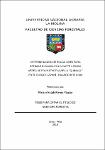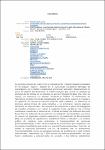Mostrar el registro sencillo del ítem
Determinación de ecuaciones para estimar biomasa en la parte leñosa aérea de Polylepis flavipila "Quinual" en el bosque Japaní - Huarochirí, Lima
| dc.contributor.advisor | Barrena Arroyo, Víctor Manuel | |
| dc.contributor.author | Rivera Paucar, Miriam Natalí | |
| dc.date.accessioned | 2018-04-16T18:51:35Z | |
| dc.date.available | 2018-04-16T18:51:35Z | |
| dc.date.issued | 2018 | |
| dc.identifier.other | K10.R59-T BAN UNALM | |
| dc.identifier.uri | https://hdl.handle.net/20.500.12996/3182 | |
| dc.description | Universidad Nacional Agraria La Molina. Facultad de Ciencias Forestales. Departamento Académico de Manejo Forestal | es_PE |
| dc.description.abstract | El presente estudio se realizó con 40 individuos de Polylepis flavipila evaluados en el bosque “Japaní”, situado en la comunidad campesina Santiago de Carampoma en el distrito Carampoma, provincia Huarochirí, departamento de Lima. El objetivo fue determinar la mejor ecuación que estime la cantidad de biomasa aérea leñosa de los árboles en pie de Polylepis flavipila. Para ello, en campo, se evaluaron los árboles mediante el método no destructivo, en laboratorio se determinó la densidad básica del fuste de la especie en estudio y en gabinete se calculó el volumen total de cada individuo, se determinó la biomasa aérea leñosa de cada individuo y se eliminaron valores atípicos; asimismo se seleccionaron 100 modelos de ecuaciones a partir de bibliografía de estudios similares y se realizó la regresión lineal basada en los mínimos cuadrados a través de la herramienta “Análisis de Datos” del software Microsoft Excel. Para la selección de ecuaciones, se analizaron los resultados y se tomó en cuenta los siguientes criterios estadísticos: el coeficiente de determinación (R2), las pruebas de significancia estadística Fisher y t-Student y el análisis gráfico de residuos para determinar la homogeneidad de varianzas (homocedasticidad). Fueron 45 los modelos de ecuaciones que cumplieron con los criterios estadísticos, pero solo uno presentó homocedasticidad. Ante ello, se realizó la regresión ponderada con los 44 modelos que no presentaron homocedasticidad, donde se agregaron factores de ponderación a cada modelo seleccionado, obteniendo así 1 625 nuevas ecuaciones ponderadas, las que fueron analizadas y seleccionadas de acuerdo a los criterios estadísticos mostrados anteriormente. De estas solo tres ecuaciones ponderadas lograron homogenizar la varianza de sus residuos; finalmente para seleccionar la mejor ecuación se calculó y comparó su Índice de Furnival de las cuatro ecuaciones que presentaron homocedasticidad, donde se llegó a la conclusión que la mejor ecuación que estima la biomasa aérea leñosa de los árboles de Polylepis flavipila es: B = - 0,026291 + 0,001652 d1, 3*h. | es_PE |
| dc.description.abstract | The present study was carried out with 40 individuals of Polylepis flavipila evaluated in the "Japaní" forest, located in the rural community of Santiago de Carampoma in the Carampoma district, Huarochirí province, department of Lima. The objective was to determine the best equation estimating the amount of woody aerial biomass of standing trees of Polylepis flavipila. To do this, in the field, the trees were evaluated by means of the non-destructive method, in laboratory the basic density of the stem of the species under study was determined and in the cabinet the total volume of each individual was calculated, the woody aerial biomass of each Individual and atypical values were eliminated; 100 models of equations were also selected from bibliographies of similar studies and linear regression based on the least squares was performed through the tool "Data Analysis" of Microsoft Excel software. For the selection of equations, the results were analyzed and the following statistical criteria were taken into account: the coefficient of determination (R2), the tests of statistical significance Fisher and tStudent and the graphic analysis of residues to determine the homogeneity of variances (Homoscedasticity). There were 45 models of equations that met the statistical criteria but only one presented homoscedasticity. The weighted regression was performed with the 44 models that did not present homoscedasticity, where weighting factors were added to each selected model, obtaining 1 625 new weighted equations, which were analyzed and selected according to the statistical criteria shown above. Of these, only three weighted equations were able to homogenize the variance of their residues; Finally, to select the best equation, we calculated and compared its Furnival index of the four equations that presented homoscedasticity, where it was concluded that the best equation that estimates the woody aerial biomass of the trees of Polylepis flavipila is: B = - 0, 026291 + 0.001652 d1, 3 * h. | en_US |
| dc.description.uri | Tesis | es_PE |
| dc.format | application/pdf | en_US |
| dc.language.iso | spa | es_PE |
| dc.publisher | Universidad Nacional Agraria La Molina | es_PE |
| dc.rights | info:eu-repo/semantics/openAccess | en_US |
| dc.rights.uri | https://creativecommons.org/licenses/by-nc-nd/4.0/ | * |
| dc.source | Universidad Nacional Agraria La Molina | es_PE |
| dc.source | Repositorio institucional - UNALM | es_PE |
| dc.subject | Rosaceae | es_PE |
| dc.subject | Arboles forestales | es_PE |
| dc.subject | Biomasa | es_PE |
| dc.subject | Cambio climático | es_PE |
| dc.subject | Dendrometría | es_PE |
| dc.subject | Densidad del rodal | es_PE |
| dc.subject | Medición | es_PE |
| dc.subject | Evaluación | es_PE |
| dc.subject | Métodos estadísticos | es_PE |
| dc.subject | Perú | es_PE |
| dc.subject | Polylepis flavipila | es_PE |
| dc.subject | Poblaciones altoandinas | es_PE |
| dc.subject | Bosque Japaní | es_PE |
| dc.subject | Carampoma (dist) | es_PE |
| dc.subject | Huarochiri (prov) | es_PE |
| dc.subject | Lima (dpto) | es_PE |
| dc.title | Determinación de ecuaciones para estimar biomasa en la parte leñosa aérea de Polylepis flavipila "Quinual" en el bosque Japaní - Huarochirí, Lima | es_PE |
| dc.type | info:eu-repo/semantics/bachelorThesis | en_US |
| thesis.degree.discipline | Manejo Forestal | es_PE |
| thesis.degree.grantor | Universidad Nacional Agraria La Molina. Facultad de Ciencias Forestales | es_PE |
| thesis.degree.name | Ingeniero Forestal | es_PE |
| thesis.degree.level | Título Profesional | es_PE |
| dc.subject.ocde | http://purl.org/pe-repo/ocde/ford#4.01.02 | es_PE |
Ficheros en el ítem
Este ítem aparece en la(s) siguiente(s) colección(ones)
-
CFO-MF Tesis [241]




